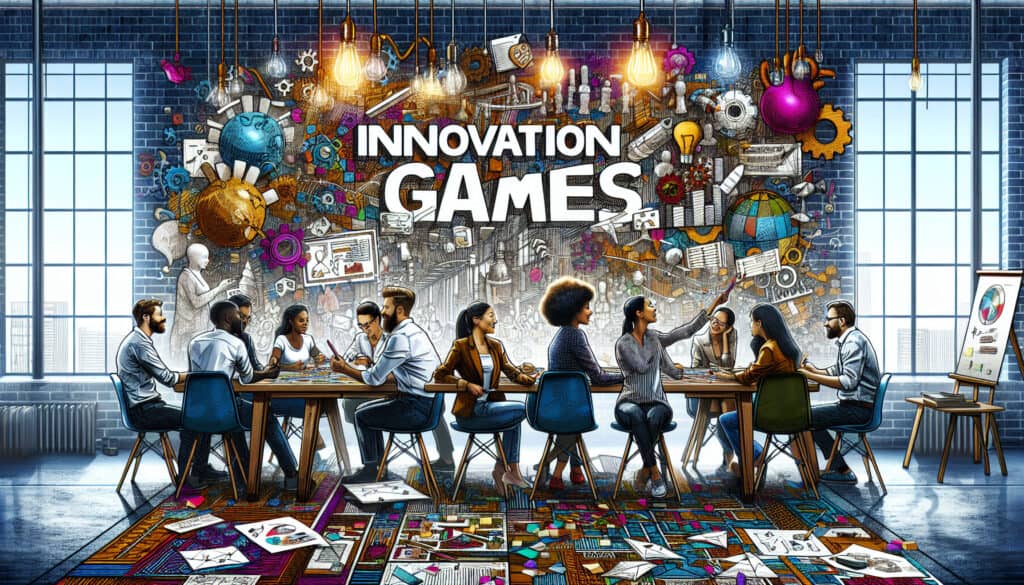A set of collaborative exercises for understanding customer needs and designing new products.
- Méthodologies : Clients et marketing, Idéation, Conception de Produits
Jeux d'innovation

Jeux d'innovation
- Méthodologie Agile, Expérience client, Cartographie de l'itinéraire du client, Pensée conceptuelle, Innovation, Étude de marché, Prototypage, Expérience utilisateur (UX), User-Centered Design
Objectif :
Comment il est utilisé :
- A collection of qualitative research methods that use games to help customers articulate their needs and desires. These games are designed to be more engaging and insightful than traditional market research techniques.
Avantages
- Provides deep insights into customer needs; Can be more engaging and fun than traditional research methods.
Inconvénients
- Can be time-consuming and expensive to conduct; Requires a skilled facilitator.
Catégories :
- Clients et marketing, Conception de Produits
Idéal pour :
- Understanding customer needs and designing new products and services in a collaborative and engaging way.
Innovation Games can be particularly beneficial in sectors such as technology, consumer goods, healthcare, and automotive industries, where understanding user requirements is pivotal for product development. These engaging methodologies can be utilized in various project phases, notably during ideation and concept validation, often following traditional research approaches to enrich the data collected. Sessions typically involve cross-functional teams, including product designers, engineers, marketers, and actual customers, who collaborate to shape product concepts based on real-world feedback. Specific game formats, such as “Product Box” or “Empathy Mapping,” encourage participants to express their thoughts creatively, allowing for a deeper exploration of desires and pain points beyond surface-level responses. These sessions can be facilitated in workshops, design sprints, or focus groups, making them adaptable to different organizational cultures. Furthermore, the playful nature of these games can reduce the pressure participants often feel during conventional interviews, leading to more authentic and candid responses. The combination of fun and structured activities generates a rich tapestry of qualitative data, ultimately contributing to more innovative and customer-centric product solutions.
Principales étapes de cette méthodologie
- Choose a specific game type appropriate for the research goal.
- Facilitate the game, ensuring participants understand the rules and objectives.
- Encourage open dialogue among participants during gameplay.
- Observe interactions and note emerging themes and ideas.
- Capture visual and verbal outputs generated during the game.
- Debrief with participants to explore deeper meanings behind their contributions.
- Identify patterns and clusters from the collected outputs.
- Translate findings into actionable product or service concepts.
Conseils de pro
- Incorporate role-playing elements into games to create realistic scenarios that reveal deeper motivations and pain points around product usage.
- Utilize mixed methods within Innovation Games, combining qualitative data from game results with quantitative data from traditional research for well-rounded analysis.
- Encourage collaborative brainstorming sessions post-game to synthesize findings and directly s'engager participants in prioritizing their needs and desires.
Lire et comparer plusieurs méthodologies, nous recommandons le
> Référentiel méthodologique étendu <
ainsi que plus de 400 autres méthodologies.
Vos commentaires sur cette méthodologie ou des informations supplémentaires sont les bienvenus sur le site web de la Commission européenne. section des commentaires ci-dessous ↓ , ainsi que toute idée ou lien en rapport avec l'ingénierie.
Contexte historique
1949
1950
1950
1960
1960
1960
1960
1940
1950
1950
1958
1960
1960
1960
1960
(si la date est inconnue ou n'est pas pertinente, par exemple "mécanique des fluides", une estimation arrondie de son émergence notable est fournie)















Articles Similaires
Questionnaires sur les troubles musculo-squelettiques
Tests à plusieurs variables (MVT)
Analyse de régression multiple
Systèmes de capture de mouvement
Méthode MoSCoW
Test de la médiane de Mood